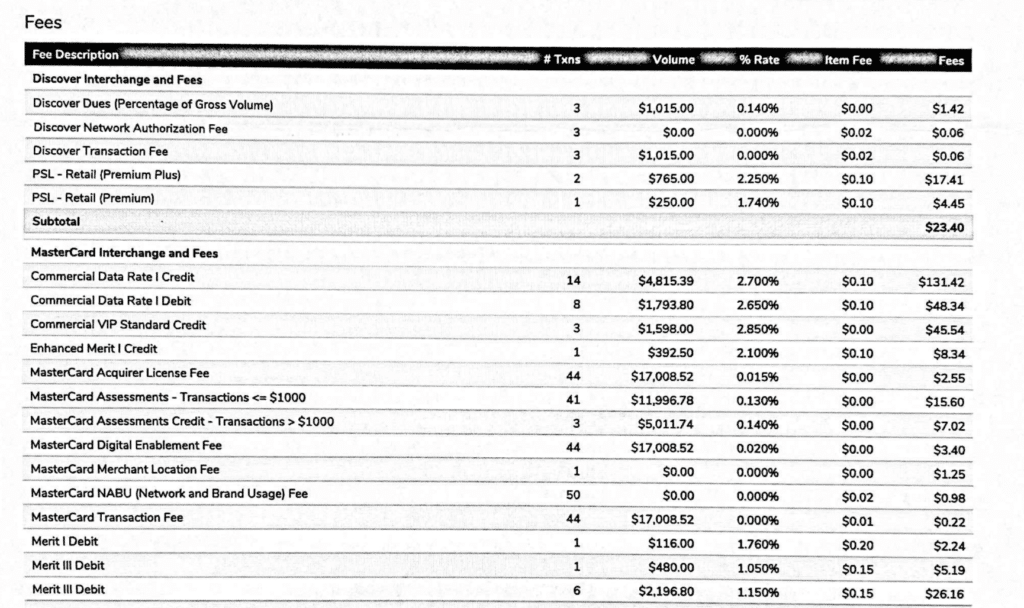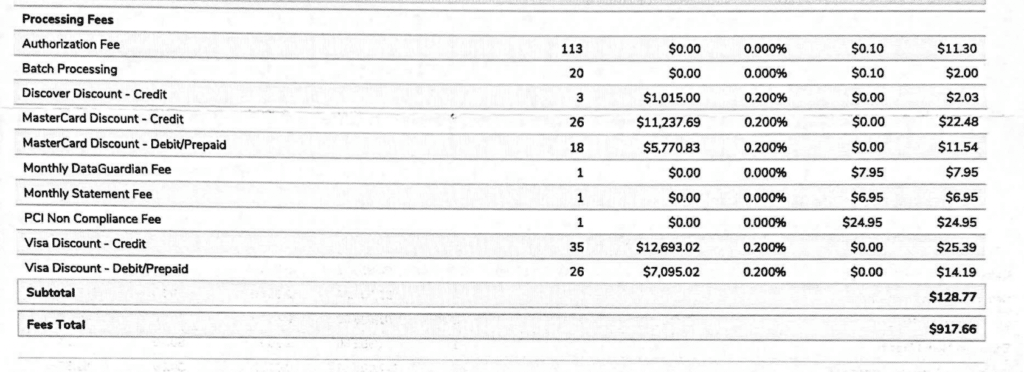Founded in 2005, Clearent is a modern payment processor that focuses on embedded payments and integrated processing. They process over $31+ billion annually from 66,000+ businesses, with a large portion of that coming from their ISV partnerships.
Whether you’re thinking of using Clearent for credit card processing or you’re currently using Clearent to process payments and want more information, you’ve come to the right place.
This review covers everything you need to know about Clearent’s processing services based on our first-hand experience negotiating with them and auditing Clearent’s statements on behalf of our clients.
MCC Quick Take on Clearent
Overall, Clearent is a good payment processor. They offer decent pricing and provide exceptional customer support, which can’t be said for many of their top competitors.
In recent years, we’ve seen Clearent increasingly become the sole integrated processor for businesses—providing built-in payment solutions for merchants across a wide range of industries (which is aligned with the direction of the broader payments industry).
Pros
- Ethical, transparent, and competitive pricing.
- Interchange-plus contracts are available.
- Built-in Level 2 and Level 3 optimized rates for B2B payments
- Infrequent rate increases.
Cons
- Most accounts require a 3-year contract.
- Some merchants are onboarded to flat-rate pricing, which isn’t ideal.
- Other businesses are on tiered pricing contracts, which, again, is not as competitive as interchange plus.
- Early termination fees.
Clearent Pricing and Credit Card Processing Rates
Clearent’s pricing varies by account and contract structure with interchange-plus, tiered, and flat-rate options available.
If you’re starting a new contract with Clearent, do whatever you can to get on an interchange-plus deal. This is by far the best way to get the lowest rate, and it’s much more transparent than the alternative options.
The interchange-plus markup is usually right around 0.50% (50 basis points), give or take a few points.
It’s definitely not the lowest rate we’ve ever seen, but it’s really not that bad for an integrated processor. Plus, the fact that Clearent rarely raises its rates is a huge bonus. Another processor might offer you a lower rate, but you’ll end up paying more in two or three years when they hike your fees.
While I can’t predict that Clearent won’t raise their rates on you soon after you start working with them, history is definitely on your side.
Flat Rate Pricing Example
Here’s a statement from one of our clients on a flat-rate plan with Clearent:
As you can see, they’re paying 2.59% for all transactions—Visa, Mastercard, Amex, Discover, and debit cards.
With a few other fees, this merchant’s effective rate is slightly higher at 2.65% for the billing cycle. This isn’t terrible for flat-rate pricing, but it can definitely be lower if they were on an interchange-plus deal.
For instance, it’s so much cheaper at the interchange level to process debit cards. This could be almost a full percentage lower, and yet the merchant is paying the same rate for these transactions as they are for American Express credit cards.
To add extra context, this merchant processed over $266,807 in payments during this statement period. This is important information to consider for comparison purposes as we look at an interchange-plus statement below.
Interchange Plus Pricing Example
If you’re on an interchange-plus contract from Clearent, you’ll see a complete breakdown of all the different interchange categories based on the card network and transaction type.
This is the most transparent pricing available, as you’re getting the wholesale rates.
For example, Mastercard debit rates here were charged as low as 1.05% + $0.15 per transaction (before the processor markup). If we compare this to the flat-rate statement that we reviewed earlier, it’s over 150 basis points lower.
And if we continue deeper into this IC+ statement, we’ll see the actual discount rates charged by Clearent:
This merchant is paying Clearent a 0.20% + $0.10 per translation markup, which is a really good deal.
But here’s the crazier part—this merchant only processed $37,811 during this statement period. If you recall, the flat-rate example that we reviewed earlier was $266,807.
Processors reward volume. And even though the flat-rate merchant processed more than 7x than the IC+ merchant, the IC+ still got a significantly lower rate.
This tells me two things. If the flat-rate merchant did less volume, their rate would be even higher, and if the IC+ merchant did more volume, their rate would be even lower.
Other Clearent Fees to Look Out For
As previously mentioned, Clearent is typically very ethical when it comes to rates and fees. We rarely find them trying to bury hidden fees in statements, and we’ve never caught them padding assessments (which is one of the worst things a processor can do).
That said, here are a handful of fees that you might encounter:
- Monthly Statement Fee — $6.95 per month
- PCI Non-Compliance Fee — $24.95 per month
- Authorization Fee — $0.10 per authorization
- Batch Processing Fee — $0.10 per settled batch
- Early Termination Fee — $395
The monthly statement fee and PCI non-compliance fees can both be removed from your statement, and obviously, the early termination fee only applies if you cancel your merchant account.
You can see more Clearent fees here.
Other Useful Insights About Clearent’s Payment Processing Services
Beyond the pricing, here are some additional pieces of information that I think you’ll find useful if you’re considering Clearent for payment processing.
Virtual Terminal Overview
Clearent’s virtual terminal is very good, and they have excellent supporting documentation to walk you through how to make the most of it.
For security purposes, the terminal uses PAN masking to protect the card numbers and expiration dates being entered into the terminal. You can also use it to accept ACH payments (assuming you have this feature activated on your account).
It’s easy to manage and access receipts, add surcharges, search for transactions, void transactions, issue refunds, identify pending authorizations, set up recurring payments, and much more.
Monthly Reporting
Clearent’s monthly reporting is great. It’s fluff-free and gives you everything you need to quickly and accurately calculate your effective rate.
This is really refreshing because so many other processors out there make these statements incredibly difficult to read. And in many cases, they’re difficult to read because the processor is trying to hide something.
That’s not the case with Clearent. Everything is straightforward and very transparent—especially if you’re on an interchange-plus pricing plan.
Enhanced Data Optimization
I like that Clearent offers Level 2 and Level 3 enhanced data optimization for B2B accounts.
This feature is built into the system for qualifying merchants, and when enabled, you can capture additional card data and automatically qualify for lower rates when accepting commercial and B2B cards.
Other Solutions
In addition to basic payment processing and credit card processing, merchants can get other services from Clearent, including:
- Cash discount programs
- Gift cards and customer loyalty solutions
- Smart invoicing
- Merchant financing
- Payment protection
- Virtual terminals
- Recurring payments
You can also use Clearent’s APIs to embed payment transactions into other systems. They even have marketing APIs, a mobile payment SDK, and other developer-friendly tools for custom setups.
Should You Switch to Clearent?
Switching payment processors is rarely a good idea. 95% of the time you’re better off sticking with your current provider and negotiating new terms.
This holds true for anyone who’s considering switching to Clearent.
While I like Clearent for a lot of reasons, they really aren’t doing anything groundbreaking, and there’s a good chance your processor can offer the same or similar solutions. As for the rate, that’s something that can be negotiated with your provider as well.
That said, if you’re a new business looking for a new payment processor, Clearent should definitely be on your radar—especially if you’re looking for an integrated setup.
Our Final Thoughts on Clearent
Clearent is solid. They’re an above-average processor that’s bumped up a notch or two higher because they rarely raise rates, and their prices are very transparent.
Just make sure you get on an interchange-plus contract to get the best possible deal.
Still have questions about Clearent or your current processor? Contact our team here at MCC for assistance.



